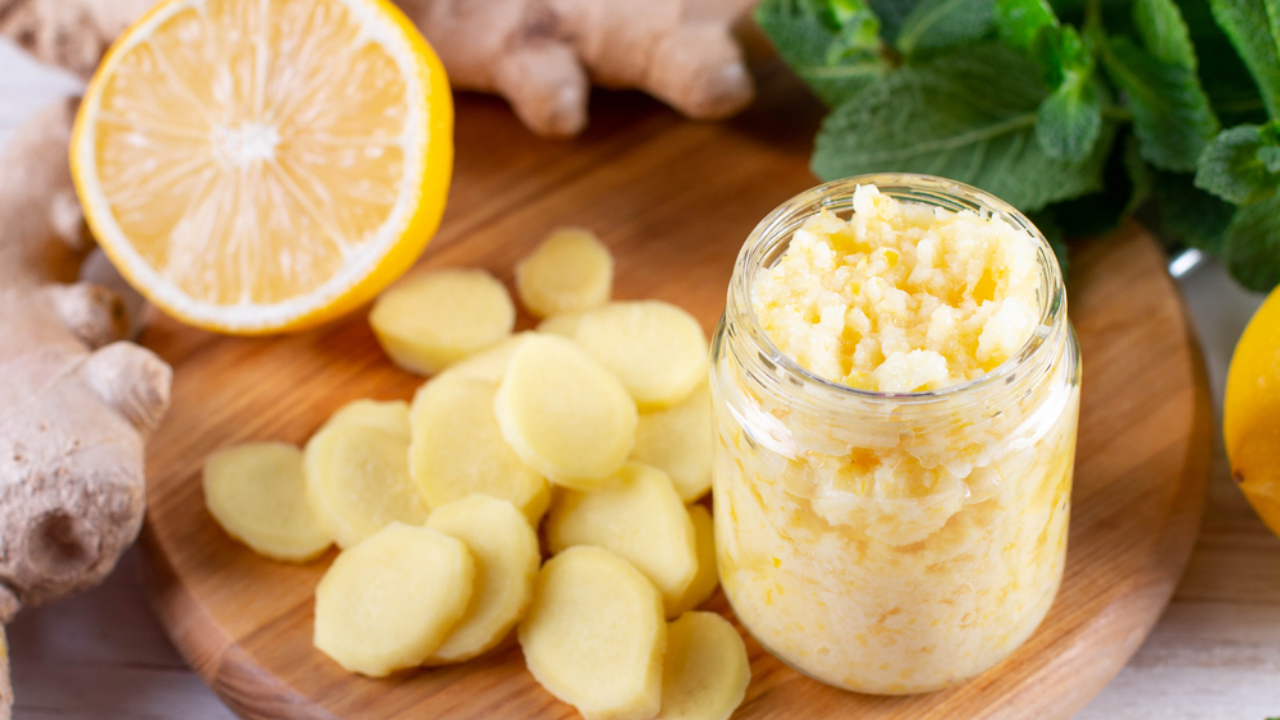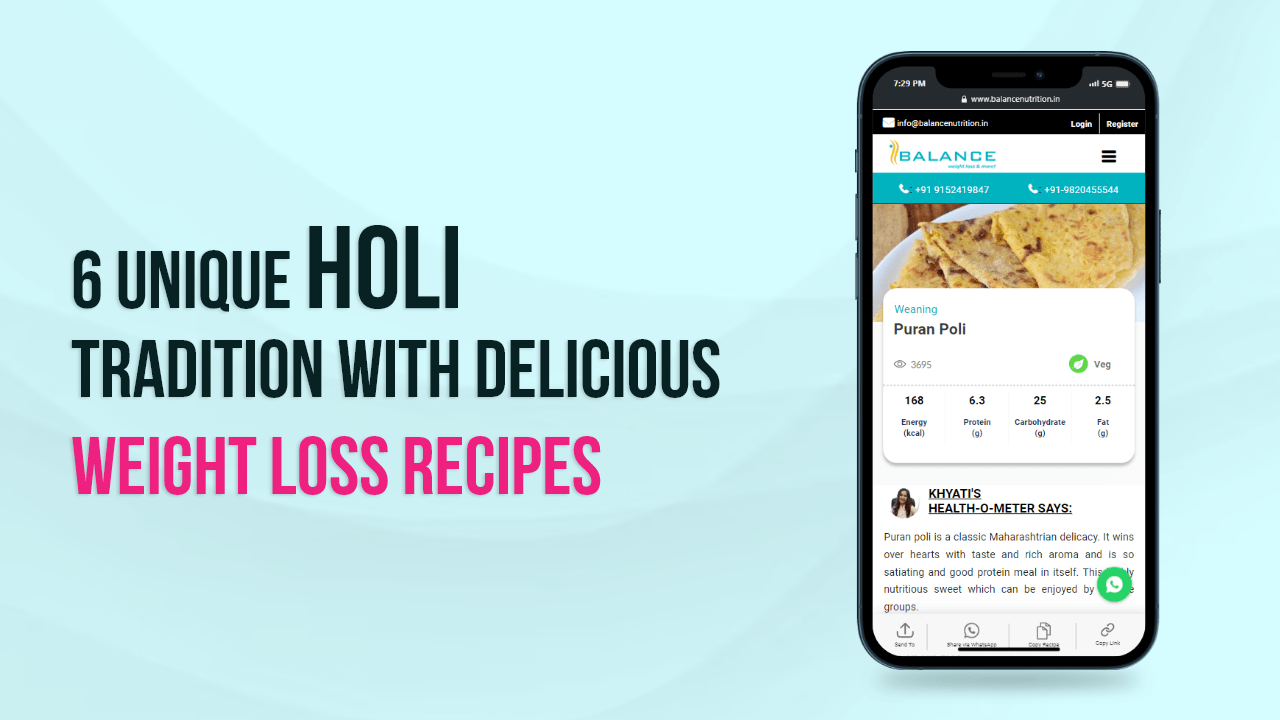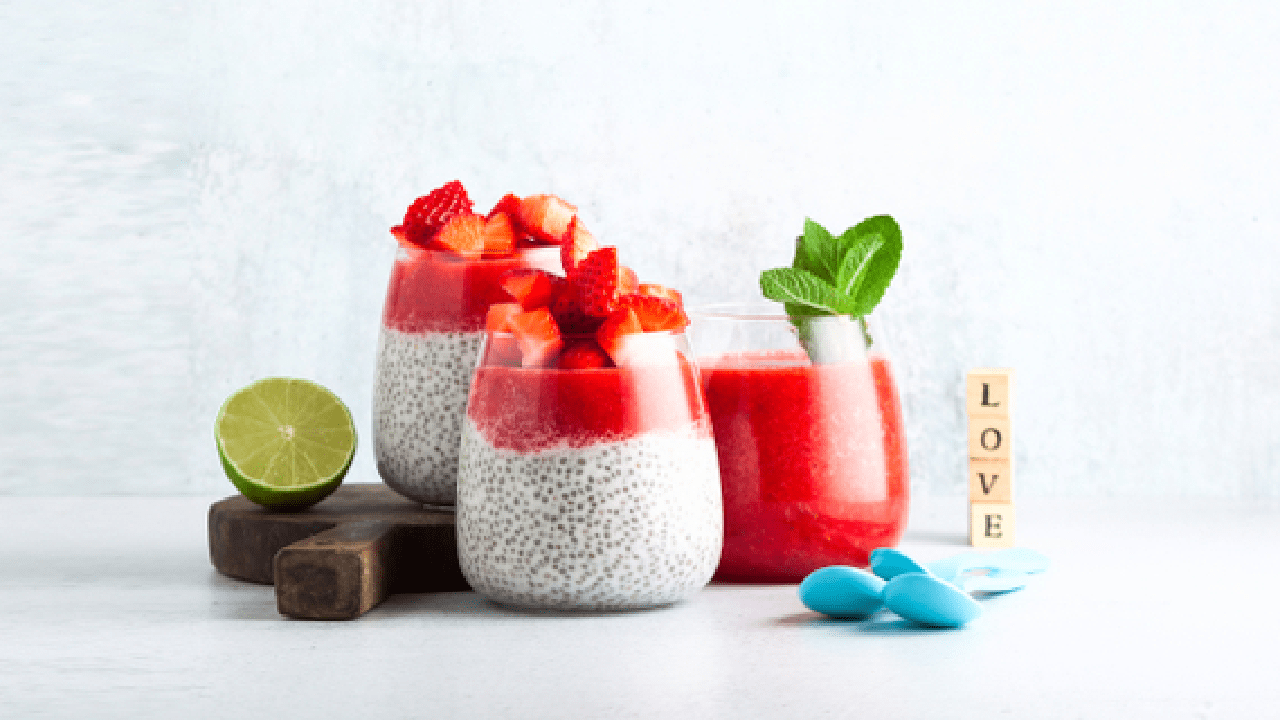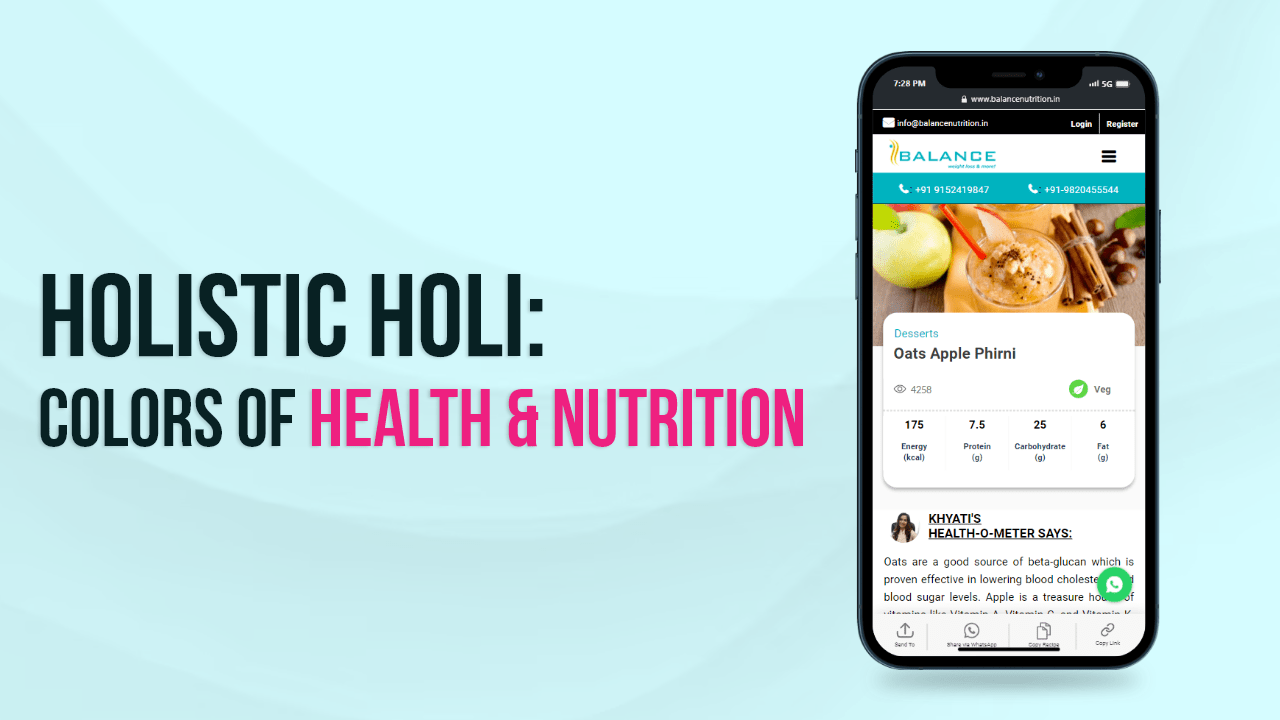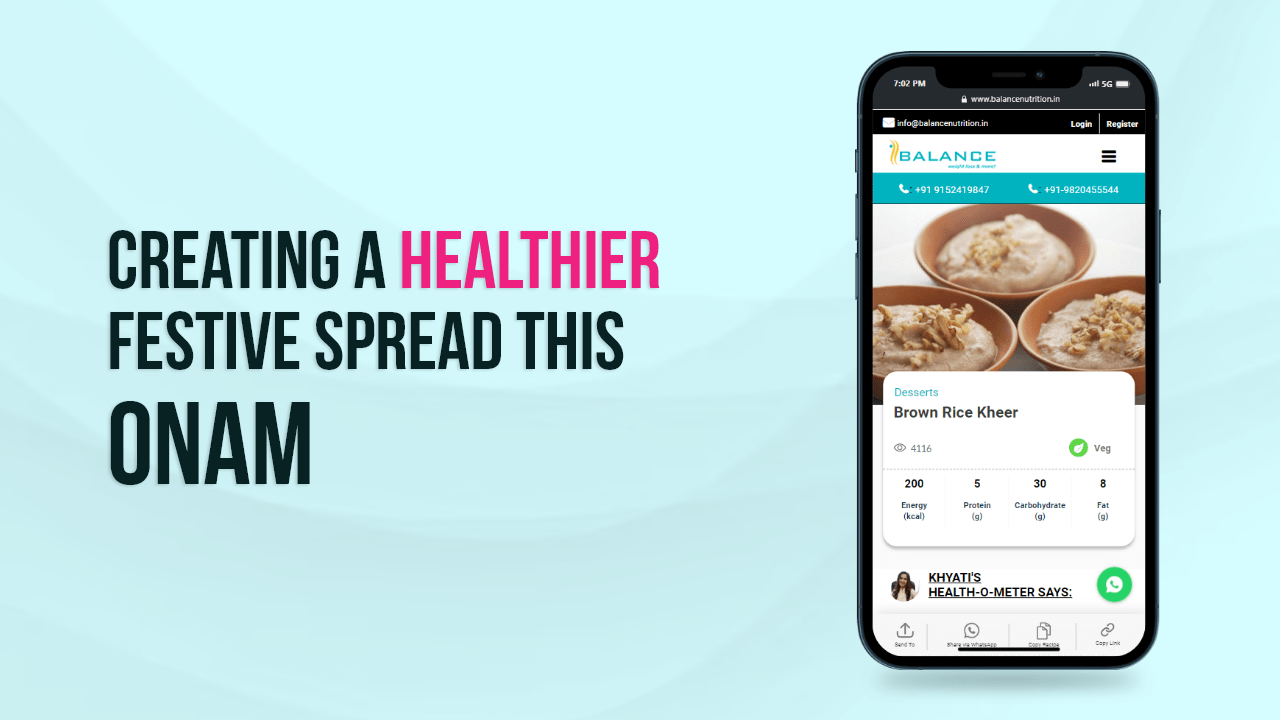
Onam is the biggest & the most important festival of the state of Kerala.The festival is celebrated to welcome King Mahabali, whose spirit is said to visit Kerala at the time of Onam. The most impressive part of Onam celebration is the grand feast called Onasadya-Vegetarian banquet which is considered to be the most important part of the onam.It is a nine course meal which strictly consists of vegetarian dishes.There can be anywhere between 13-25 dishes for Onam & this number can be higher.
The traditional dishes which are served during Kerala's rice harvest festival onam are as follows
-Main Course & Curries for Onam Festival:
1) Rice- Semi-polished rice is the rice which has not undergone rigorous polishing has the whole germ, contains most of the grain's original vitamins B1, B2, & E. In this manner, its storage capacity is increased while retaining the nutrients like thiamin,riboflavin & niacin
2) Kichadi- The prime ingredient of the recipe is Okra which is considered to be low in calories has high levels of Vitamin C, Vitamin K,Vitamin A,Folate & fiber.
3) Parippu curry- A simple & easy to cook dish which is also known as lentil curry in kerala is high in Fiber, lean protein, folate & iron.
4) Erissery- A green papaya recipe which is rich in dietary fiber, antioxidants, thiamin, folic acid, vitamin A, Vitamin C & folate.
5) Kaalan- The prime ingredient of this recipe is raw banana which is a good source of fiber, vitamins, & minerals, & contains a starch that may help control blood sugar, manage weight & lowers blood cholesterol levels.
6) Olan- Contains ash gourd & yellow pumpkin which are rich in phosphorus, calcium, riboflavin, iron, thiamine, niacin & Vitamin C.
7) Kootu curry- This healthy & tasty recipe should be added to the menu at least once in a week It is an excellent source of protein & fiber.It contains beta carotene.Also, it plays an important role in diabetes control, by suppressing the activity of certain enzymes involved in glucose production.
8) Mixed vegetable theeyal- A recipe which is similar to Sambar & is rich in Fibre,Vitamins & Minerals.
9) Pulissery- It is a simple side dish eaten by the people of kerala & is primarily made with curd.It is highly recommended as it is a low calorie vegetable,It is also an excellent source of potassium, calcium, protein, vitamin C, vitamin K, fiber & anti-oxidants.
10) Aviyal- It is a delicious preparation made with mixed vegetables & is considered to be high in protein,fibre & Vitamins.
11) Green papaya Thoran- Raw Papaya is a great source of vitamins & nutrition. It is very low in Saturated Fat, Cholesterol, & Sodium. It is also a good source of Dietary Fiber & Potassium, & a very good source of Vitamin A, Vitamin C , & Folate.
-
Stew & Soup for Onam:
1) Rasam- An all time favorite down the south primarily contains tamarind which is rich in Dietary fiber, Antioxidants, thiamin, folic acid, vitamin A, vitamin C, niacin, & riboflavin.The Black pepper in the recipe is also known to keep the weight in check.
2) Sambar- Sambar is a lentil-based vegetable stew which is a very popular dish in the state of kerala.It is a recipe which is high in proteins,fiber, and is known to have a low glycemic index.
-
STIR-FRY:
1) Mezhkkupuratt- Also known as south Indian stir-fry is high in Fibre, Vitamins, & minerals.
-
Accompaniments to have with special dishes on Onam:
1) Puliyinji- A hot & sour dish which contains tamarind which is rich in Dietary fiber,Antioxidants, thiamin, folic acid, vitamin A, vitamin C, niacin, & riboflavin
2) Mulaka pachadi- A unique flavored pachadi (chutney) is an important part of the feast & is relished by one & all.Pachadi is low in calories & High in fiber.
3) Achaaru- The feast consists of 2 different types of pickles namely mango pickle & lemon pickle which are specially made for the occasion & are known to have high amounts of Vitamin C.
4) Pappadam- It is considered to be an integral part of the sadya fest & is primarily made of lentils or black gram dal & are high in fiber & protein rich
-
DESSERTS:
1) Payasam- The south Indian version of the very popular kheer is considered to be an integral part of sadya is high in calcium, fiber, iron & selenium.
2) Pradhaman- Pradhaman means foremost in position in Malayalam.It is known as the king of all the payasams & is a signature dish of Kerala.And yet again is rich in fiber, protein, & Iron.
The most important features of the dishes served in this festival are that they make use of semi-polished brown rice, lentils, vegetables like okra, ash gourd which are not only low in calories but are also high in protein, fiber, vitamins, and minerals.
Another important part of Onasadya is that the meals are strictly served on a banana leaf.The banana leaves are not only a traditional way of serving the dishes but are considered equally healthy, flavourful, hygienic & practical.The banana leaves are considered healthy because they contain a polyphenol named epigallocatechin gallate(EGCG)which is absorbed by the food that is placed on the leaves.The wax coating on the leaves imparts a distinct flavor to the food hence making it tasty.
So ideally there is nothing to worry as the onam dishes can be cooked in a healthy way & here are some of the recipes which you can cook & consume without any fear.So let's take a quick look at the recipes given below.
-
Healthy Onam Recipes
PESARATTU:
INGREDIENTS:
- Whole Green Gram-1 cup
- Cumin seeds-1/2Tsp
- Ginger-1/2"
- Thai green pepper-1
- Salt to taste
- Onion (chopped finely)-1/2
METHOD:
Step 1 Soak Moong Dal for 3-4 hrs.
Step 2 Grind the soaked moong Dal with cumin seeds, ginger, salt & green peppers for 10-12 minutes.
Step 3 Make pancakes & sprinkle few chopped onion pieces on top with little oil.
Step 4 Serve hot with mint coriander chutney
KHYATI 'S HEALTH-O-METER
Green moong is considered to be a perfect slimming food .It is not only it is low in fats, green bean is also a rich source of protein, & fiber which enables one to lower the high cholesterol level in body system. The high fibre in green moong yields complex carbohydrate which improves digestion.It may also prove beneficial for people suffering with diabetis.Not only that green moong also has high levels of iron & folate. So overall pesarattu is a powerpacked, delicious & healthy option to consume.
NUTRITIVE VALUE: PER SERVING:
| Energy (kcals) | 126.4 |
| Protein (g) | 4.6 |
| Fat (g) | 5.3 |
| Dietary fiber (g) | 4.7 |
-
SADYA PARIPPU:
INGREDIENTS:
- 1/2 cup split pigeon pea or toor dal
- 2-3 shallots or pearl onions finely sliced
- 1 clove garlic; finely chopped
- 1/2 piece ginger, finely chopped
- 1 green chillies, slit lengthwise
- 1 Tsp oil
- 1 sprig of curry leaves, crushed between the palms to enhance flavor.
- 1-2Cups of water
METHOD:
Step 1 To begin making the Sadya Parippu , pressure cook the split pigeon pea or toor dal in two cups of water along with the pearl onions, garlic, ginger, green chillies, a few curry leaves, a pinch of salt.
Step 2 Once the pressure is released in the cooker mash the lentils lightly with a masher.
Step 3 Now, add in the oil & the curry leaves to the dal. Cover this & simmer on low heat for about 5 minutes.
Step 4 Serve the steaming hot Sadya Parippu with brown rice.
Step 5 This dish uses split pigeon peas, which do not require much water for cooking.
Step 6 On the other hand, if you are using green gram lentils or moong dal, make sure you add at least 1 & 1/2 cups of water for 1/2 cup of the lentils, to ensure the lentils are cooked well & are also the right consistency.
Step 7 Adding garlic & pearl onions is important but not mandatory. Parippu prepared for sadya can make do without these ingredients.
Step 8 The dish needs to be of semi-thick consistency. Therefore adjust the cooking accordingly.
Step 9 The dish needs to be of semi-thick consistency. Therefore adjust the cooking accordingly
Step 10 Ash gourd or yellow cucumber cubes can also be added to the cooked dal or placed in the dal before cooking. These vegetables make the dish nutritious & healthy.
NUTRITIVE VALUE: PER SERVING:
| Energy (kcals) | 62.4 |
| Protein (g) | 2.7 |
| Fat (g) | 2.5 |
| Dietary fiber (g) | 3.3 |
KHYATI'S HEALTH-O-METER
Lentils such as pigeon pea & tur dal are a powerhouse of nutrition.They are particularly rich in dietary fiber, lean protein, folate, & iron.Apart from that they are also considered to be a good source of potassium, calcium, zinc, niacin & vitamin K.Parippu is hence a wonderful recipe packed with nutrients that can be easily relished during onam.
-
PULIYODHARAI(Tamarind rice):
INGREDIENTS:
- 1 cup of Brown rice
- 2 Tbsp Oil
Ingredients for Pulikachal (Puliyodharai / Puliyogare Spice Mix)
- 1 big lemon sized tamarind
- 1/2 teaspoon jaggery
- Salt & Water as needed
Ingredients To Roast & Grind For Pulikachal
- 1 tablespoons channa dal
- 2 dry red chillies
- 1-2 teaspoons fenugreek seeds
- 1/2 teaspoon whole black pepper
Ingredients For the Seasoning of Pulikachal
- 1 tsp mustard seeds
- 2 dry red chillies
- 1 tsp channa dal
- 1/2 teaspoon asafoetida
- 1 1/2 teaspoon turmeric powder
- 4-5 curry leaves
- 2 tsp sesame oil
METHOD:
Step 1 Soak the tamarind in water for at least one hour & extract the juice. Keep the juice aside
Step 2 Take all the ingredients listed under Roast & Grind & dry roast them until it turns golden brown. Cool them completely & grind to a fine powder.
Step 3 Heat oil in a pan, add the mustard seeds, red chillies & allow it to crackle & roast for a few seconds. Add the tamarind extract, turmeric powder, salt, curry leaves & asafoetida. Add enough water to make it thin & allow it to boil for at-least 20 minutes or until the volume reduces to half.
Step 4 Once the volume has reduced to half, add the jaggery & the ground spice powder. Allow this mixture to boil for another 5 minutes or until the mixtures starts to thicken. Turn off the heat & cool the pulikachal.
Step 5 You can now mix the pulikachal with steamed rice in small quantities depending upon how tangy & how spicy you want the rice to be. Allow the rice to rest in this tangy pulikachal for at least 20 minutes before serving.
Step 6 The Puliyodharai / Puliyogare - Spicy Tamarind Rice is now ready to be served.
NUTRITIVE VALUE: PER SERVING:
| Energy (kcals) | 270.7 |
| Protein (g) | 9.0 |
| Fat (g) | 9.9 |
| Dietary fiber (g) | 4.2 |
KHYATI'S HEALTH-O-METER
Tamarind has amazing benefits.The fruit pulp is known to have antibacterial properties, it reduces cholesterol & improves heart health by preventing plaque formation.Tamarind also aids in reducing blood sugar & helps in weight reduction.On the other hand, Brown rice is considered to be rich in proteins, thiamine, calcium, magnesium, fiber, & potassium. So for those who wish to keep their weight in check or are suffering from diabetes tamarind rice can prove to be an excellent recipe owing to its low glycemic index rating which helps reduce insulin spikes.
-
KERALA OLAN WITH WHITE PUMPKIN BROWN RICE:
INGREDIENTS:
- 250 gms ash gourd, peeled, cut into chunks
- 1/2 cup black eyed beans
- 1 green chillies, slit lengthwise
- 25ml Coconut milk
- salt to taste
- 4-5 curry leaves
- 2 tsp oil
METHOD:
Step 1 To begin making the Kerala Style Olan with White Pumpkin, soak the beans in water for 2 to 3 hours & cook until soft. Keep aside.
Step 2 Steam the ash gourd (white pumpkin) with salt, until soft & cooked completely. Be careful not to overcook them, it should hold it's shape.
Step 3 In a heavy bottomed sauce pan; add in the cooked ash gourd / pumpkin, the coconut milk, curry leaves & green chillies.Stir well & bring the mixture to a brisk boil.
Step 4 Adjust gravy to get the right consistency by adding a little water if you want to make it little thinner. Make sure the gravy is not too watery. Finally add in the oil & simmer for a few more minutes.
Step 5 Turn off the heat, cover the pan & allow it to rest for about 10 minutes. This brings out the flavors from the curry leaves, green chillies & coconut. Transfer the olan to a serving bowl.
Step 6 Serve the Kerala Olan Recipe with Pumpkin & Black Eyed Beans along with, Appam or Steamed Brown Rice for lunch.
NUTRITIVE VALUE: PER SERVING:
| Energy (kcals) | 43 |
| Protein (g) | 2.0 |
| Fat (g) | 1.0 |
KHYATI'S HEALTH-O-METER-
Ash gourd has several vitamins & minerals like phosphorus, calcium, riboflavin, iron, thiamine, niacin & Vitamin C. Ash gourd contains a lot of moisture content & also minute amounts of fat, fiber, carbohydrates & protein.It is low in calories making it a suitable edible for obese & diabetic people. It has cooling effect & works as a laxative.Ash gourd is useful in flushing out toxins from the body. It increases the urine output & is beneficial in reducing inflammation.On the other hand black eyed beans are a rich source of protein,fibre,Zinc,Iron & vitamin C which is known to aid in the absorption of Iron.Overall the recipe is highly nutritious & can be easily consumed by people who wish to reduce weight & keep their blood sugar levels in check.
-
-
BROWN RICE PAYASAM:
INGREDIENTS:
- 50 gm Brown Rice
- ½ liter milk
- 5 gm cardamom powder
- 100 gm Sugar-free natural
- 1 Tbsp ghee
- 2-3 Chopped almonds
METHOD:
Step 1 Wash & soak the Brown rice for 1/2 an hour.
Step 2 Cook the rice in milk until soft.
Step 3 Add cardamom powder, sugar-free natura & stir until the sugar is dissolved.
Step 4 Heat ghee in a pan & add the almonds & wait till the almonds are slightly golden.
Step 5 Pour on the rice mixture & serve warm.
NUTRITIVE VALUE: PER SERVING:
| Energy (kcals) | 50.7 |
| Protein (g) | 0.4 |
| Fat (g) | 2.0 |
KHYATI'S HEALTH-O-METER- Brown Rice is rich in fiber & is a good source of manganese & selenium.Jaggery is rich in iron.Hence all these benefits make the payasam a power packed onam dessert.



